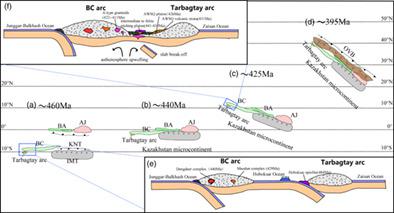当前位置:
X-MOL 学术
›
Geolog. J.
›
论文详情
Our official English website, www.x-mol.net, welcomes your
feedback! (Note: you will need to create a separate account there.)
Silurian alkaline magmatism in the Saur area, northern West Junggar: Evidence for the Middle Palaeozoic amalgamation of the Kazakhstan Block at the south‐west of the Central Asian Orogenic Belt
Geological Journal ( IF 1.4 ) Pub Date : 2020-09-23 , DOI: 10.1002/gj.3997 Fang Song 1 , Jia‐Fu Chen 1 , Bao‐Fu Han 2 , Hong‐Zhang Yang 1
Geological Journal ( IF 1.4 ) Pub Date : 2020-09-23 , DOI: 10.1002/gj.3997 Fang Song 1 , Jia‐Fu Chen 1 , Bao‐Fu Han 2 , Hong‐Zhang Yang 1
Affiliation

|
Although it is generally accepted that the Kazakhstan Block is an assemblage of Precambrian microcontinents and Early Palaeozoic island arcs, the details and timing constraint of the collage process need to be precisely studied in local regions. Thus, we conducted combined studies of geochemistry, zircon U–Pb geochronology and Sr–Nd–Hf isotopes upon the Awusiqi alkali‐feldspar granite and volcanic rocks from the Saur area in northern West Junggar. The Awusiqi volcanic rocks are mainly composed of andesites, rhyolites, and pyroclastic rocks. The alkali‐feldspar granite directly intrudes into the surrounding volcanic strata. Zircon U–Pb ages of the Awusiqi andesites, rhyolites, and alkali‐feldspar granite are 431 ± 3 Ma, 428 ± 5 Ma, and 426 ± 6 Ma, respectively. These new age data imply for the existence of Silurian magmatism in the Saur area. The alkali‐feldspar granite and rhyolites with high silica and alkali contents belong to metaluminous to weakly peraluminous and alkaline series and show seagull‐type REE patterns with strongly negative Eu anomalies. They are relatively enriched in the light rare earth elements (LREEs), K, Rb, Ba, Cs and other large‐ionic lithophile elements (LILEs), and are poor in P, Sr, and Eu, geochemically similar to those of A2‐type granites. The alkali‐feldspar granites have positive zircon εHf(t) values varying from +11.03 to +16.87 and young Hf model ages (TDM2 = 686 – 425 Ma). These features suggest that the Awusiqi alkali‐feldspar granite and rhyolites (except sample 18XJSF22C) were generated by partial melting of the juvenile lower crust with fractional crystallization, whereas sample 18XJSF22C shows mantle‐derived features. Awusiqi andesites show typical sanukitic high‐Mg andesites characteristics(Mg# = 48.08 – 65.52). The andesites are enriched in LREEs and LILEs, and are depleted in Nb, Ta, and Ti. They also have relatively high initial 87Sr/86Sr ratios (0.70543 – 0.70547), positive εNd(t) values (+2.5 – +5.7), and ancient Nd model ages (TDM1 = 1,093 – 815 Ma). These features suggest the andesites were likely derived from partial melting of a depleted mantle source previously metasomatized by slab‐derived fluids and melts. The discovery of Silurian magmatism in the Saur area has further confirmed the existence of Early Palaeozoic Tarbagtay arc basement and widespread Middle Palaeozoic A2‐type granitoids. We favor a post‐collisional setting in the Silurian in northern West Junggar, which also is the local embodiment of the Middle Palaeozoic amalgamation of the Kazakhstan Block.
中文翻译:

西准gar尔北部Saur地区志留纪碱性岩浆作用:中亚造山带西南部哈萨克斯坦地块中古生界合并的证据
尽管人们普遍认为哈萨克斯坦地块是前寒武纪微大陆和早古生代岛弧的组合,但是拼贴过程的细节和时间约束需要在当地进行精确研究。因此,我们对西准gar尔北部Saur地区的Awusiqi碱长石花岗岩和火山岩进行了地球化学,锆石U–Pb地质年代学和Sr–Nd–Hf同位素的综合研究。阿乌斯奇火山岩主要由安山岩,流纹岩和热碎屑岩组成。碱长石花岗岩直接侵入周围的火山岩地层。阿乌斯齐安山岩,流纹岩和碱长石花岗岩的锆石U–Pb年龄分别为431±3 Ma,428±5 Ma和426±6 Ma。这些新的年龄数据暗示在萨乌尔地区存在志留纪岩浆作用。具有高二氧化硅和碱含量的碱长石花岗岩和流纹岩属于金属的至弱的高铝和碱系列,并显示出具有强烈负Eu异常的海鸥型REE模式。它们相对富含轻稀土元素(LREEs),K,Rb,Ba,Cs和其他大离子亲石元素(LILEs),并且P,Sr和Eu的地球化学性质与A相似2型花岗岩。碱长石花岗岩的正锆石εHf(t)值在+11.03至+16.87之间变化,并且具有年轻的Hf模型年龄(T DM2 = 686 – 425 Ma)。这些特征表明,Awusiqi碱-长石花岗岩和流纹岩(样品18XJSF22C除外)是通过部分熔融少年下壳的部分结晶而生成的,而样品18XJSF22C具有地幔衍生的特征。阿乌斯奇安山岩表现出典型的高镁镁质安山岩特征(Mg # = 48.08 – 65.52)。安山岩富含LREE和LILE,而Nb,Ta和Ti则贫化。它们还具有相对较高的初始87 Sr / 86 Sr比(0.70543 – 0.70547),正εNd(t)值(+2.5 – +5.7)和古老的Nd模型年龄(T DM1 = 1,093 – 815 Ma)。这些特征表明,安山岩可能源自贫化的地幔源的部分融化,该地幔源以前是由板状流体和熔体进行交代的。Saur地区志留纪岩浆作用的发现进一步证实了早古生代Tarbagtay弧形基底和广泛的中古生代A 2型花岗岩的存在。我们倾向于在准Jung尔北部的志留纪发生碰撞后的环境,这也是哈萨克斯坦地块中古生界合并的局部体现。
更新日期:2020-09-23
中文翻译:

西准gar尔北部Saur地区志留纪碱性岩浆作用:中亚造山带西南部哈萨克斯坦地块中古生界合并的证据
尽管人们普遍认为哈萨克斯坦地块是前寒武纪微大陆和早古生代岛弧的组合,但是拼贴过程的细节和时间约束需要在当地进行精确研究。因此,我们对西准gar尔北部Saur地区的Awusiqi碱长石花岗岩和火山岩进行了地球化学,锆石U–Pb地质年代学和Sr–Nd–Hf同位素的综合研究。阿乌斯奇火山岩主要由安山岩,流纹岩和热碎屑岩组成。碱长石花岗岩直接侵入周围的火山岩地层。阿乌斯齐安山岩,流纹岩和碱长石花岗岩的锆石U–Pb年龄分别为431±3 Ma,428±5 Ma和426±6 Ma。这些新的年龄数据暗示在萨乌尔地区存在志留纪岩浆作用。具有高二氧化硅和碱含量的碱长石花岗岩和流纹岩属于金属的至弱的高铝和碱系列,并显示出具有强烈负Eu异常的海鸥型REE模式。它们相对富含轻稀土元素(LREEs),K,Rb,Ba,Cs和其他大离子亲石元素(LILEs),并且P,Sr和Eu的地球化学性质与A相似2型花岗岩。碱长石花岗岩的正锆石εHf(t)值在+11.03至+16.87之间变化,并且具有年轻的Hf模型年龄(T DM2 = 686 – 425 Ma)。这些特征表明,Awusiqi碱-长石花岗岩和流纹岩(样品18XJSF22C除外)是通过部分熔融少年下壳的部分结晶而生成的,而样品18XJSF22C具有地幔衍生的特征。阿乌斯奇安山岩表现出典型的高镁镁质安山岩特征(Mg # = 48.08 – 65.52)。安山岩富含LREE和LILE,而Nb,Ta和Ti则贫化。它们还具有相对较高的初始87 Sr / 86 Sr比(0.70543 – 0.70547),正εNd(t)值(+2.5 – +5.7)和古老的Nd模型年龄(T DM1 = 1,093 – 815 Ma)。这些特征表明,安山岩可能源自贫化的地幔源的部分融化,该地幔源以前是由板状流体和熔体进行交代的。Saur地区志留纪岩浆作用的发现进一步证实了早古生代Tarbagtay弧形基底和广泛的中古生代A 2型花岗岩的存在。我们倾向于在准Jung尔北部的志留纪发生碰撞后的环境,这也是哈萨克斯坦地块中古生界合并的局部体现。










































 京公网安备 11010802027423号
京公网安备 11010802027423号